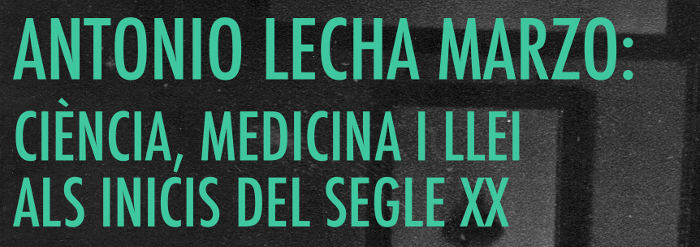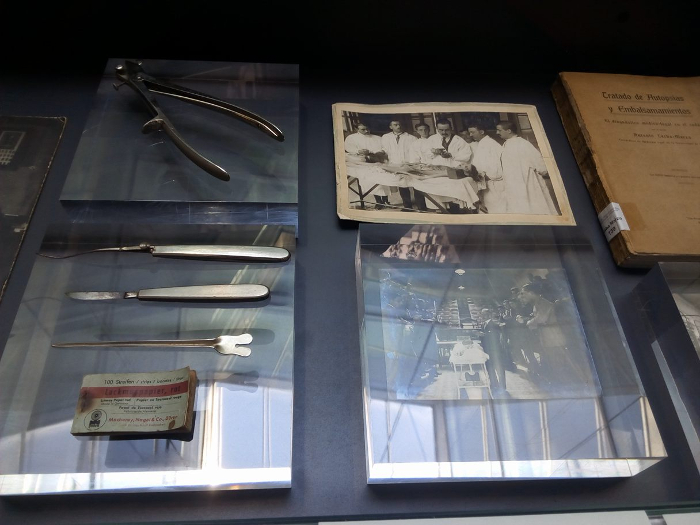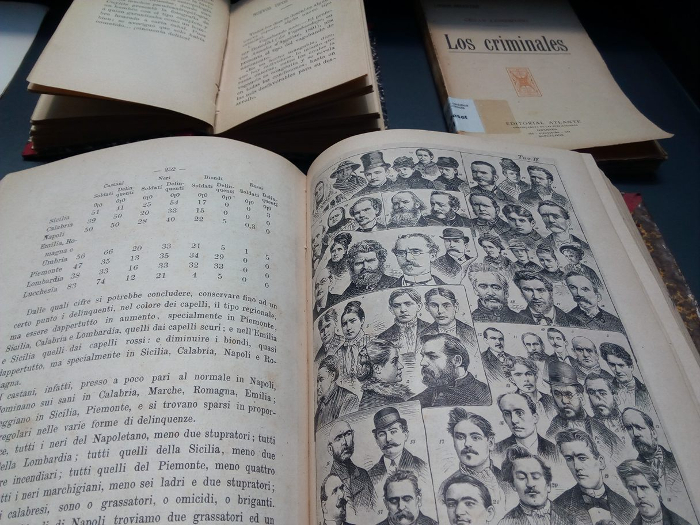
Palau de Cerveró, Biblioteca Vicente Peset Llorca
The Universitat de València presents the legacy of the forensic pathologist Antonio Lecha-Marzo, one of the pioneers of the scientific police at the beginning of the 20th century, currently known as forensic medicine. The legacy of this researcher and indefatigable scientist lays the foundation of modern criminology and criminalistics. Now it can be visited in form of exhibition at Palau Cerveró. Some of the materials available at this exhibition are: manuals, researches, photographs, reflections, medical and forensic advice, advances as well as conversations and information exchange with other international pioneers in this field.
The personal archive of Lecha-Marzo contains may letters of huge scientific value, which have been recently donated by the family of the forensic pathologist to the Vicent Peset Llorca Library of the Institute López Piñero for the History of Medicine and Science (IHMC). Thanks to the labour of the library’s team, under the direction of José Enrique Ucedo, the legacy is completely catalogued for the first time and available for future research. To celebrate this achievement, an exhibition coordinated by Mabel Fuentes has been organised, with a selection of the documentation. The exhibition was inaugurated the past 10 January 2018 at 6 pm in the Palau Cerveró of the Universitat de València. The inauguration benefited from the participation of the granddaughter of the forensic pathologist, Carmen de Meer Lecha-Marzo, who is also the author of one of the best bibliographical work about his grandfather (Meer Lecha-Març 1985). The origin of the scientific police can now be known thanks to a huge collection of bibliographical material, manuscripts and photographs of that period.

The exhibition
The exhibition is divided into four blocks which compile the interdisciplinary work of Lecha-Marzo. Some materials related to his dedication to legal and forensic medicine are available at the first glass cabinet. Two editions of this Treatise on autopsies and embalming. The legal-medical diagnosis of the corpse as well as the Manual of Legal Medicine of his uncle, Luis Lecha Martínez, in which Lecha-Marzo also collaborated. These volumes are complemented by photographic documentation and several surgical devices broadly used in the practice of autopsies. It is also included a sample of tornasol paper, used to remember the proof Lecha-Marzo proposed to confirm death, in opposition to previous forms of checking acidosis. As it has been pointed out, this technique consisted on applying a sheet of tornasol paper on the eye globe under the eyelids, to check the presence of an acid mean -blue coloration- as a sign of death.
The exhibition is divided into four blocks which compile the interdisciplinary work of Lecha-Marzo. Some materials related to his dedication to legal and forensic medicine are available at the first glass cabinet. Two editions of this Treatise on autopsies and embalming. The legal-medical diagnosis of the corpse as well as the Manual of Legal Medicine of his uncle, Luis Lecha Martínez, in which Lecha-Marzo also collaborated. These volumes are complemented by photographic documentation and several surgical devices broadly used in the practice of autopsies. It is also included a sample of tornasol paper, used to remember the proof Lecha-Marzo proposed to confirm death, in opposition to previous forms of checking acidosis. As it has been pointed out, this technique consisted on applying a sheet of tornasol paper on the eye globe under the eyelids, to check the presence of an acid mean -blue coloration- as a sign of death.
The second glass cabinet shows that Lecha-Marzo was not only a persistent researcher, but also a great writer and author of profuse correspondence. He carried through a dissemination campaign of Spanish scientific production, framed into the regeneration movement of that period. He frequently collaborated with several national and international medical publications, for instance with Los progresos de la clínica or Justicia y Sanidad. There are also available some examples of the profuse specialised correspondence which Lecha-Marzo kept with other doctors and criminologists of that period, such as Joan Peset Aleixandre, Federico Olóriz, Juan Vucetich or José Chabás. In other research line, Gregorio Marañón, Teófilo Hernando and Manuel Tapia propose Lecha-Marzo writing a monography on relevant medical topics on that period and, on a telephone call, Joan Peset Aleixandre accepts as an honour a posthumous publication of Lecha-Marzo. Some appreciation and greeting postcards addressed to Antonio Lecha-Marzo can be found, sent by Cesare Lombroso and Santiago Ramón y Cajal.
The third glass cabinet shows examples of the diverse researches on the fields of criminology and criminalistics. Los Criminales by Cesare Lombroso (1835-1909), Manuel de dactyloscopie by Antonio Lecha-Marzo and Henri Welsch and Instructions signalétiques by Alphonse Bertillon (1853-1914) are some examples of these works. Another short edition in educational format is displayed. It was edited and published by the Junta para Ampliación de Estudios e Investigaciones Científicas, about the topic in which the doctoral dissertation of Lecha-Marzo was based: papillary ridges as a mean of identification. Two more works by Lombroso, the great reference in criminal anthropology for Lecha-Marzo are also exhibited in this glass cabinet: L’uomo delinquente and Los últimos progresos de la antropología criminal. In these works, Lombroso links criminality with certain physical features of the human body, in both physical appearance and genetic heredity.

Cesare Lombroso, L’uomo delinquente: in rapporto all'antropologia, alla giurisprudenza ed alle discipline carcerarie, Torí, Fratelli Bocca, 1884.
The last glass cabinet adds to the previous one a print by the French police inspector Alphonse Bertillon. It contains a great variety of anatomic features -ears, nose, eyes, etc.- to elaborate the “spoken portrait” of criminals. These short and ruled descriptions were intended to be employed by the police to identify individuals previously marked as suspects. Another police technique developed by Alphonse Bertillon was the detailed anthropometric measurements known as bertillonage, which competed with fingerprints as the new techniques of identification at the beginning of the 20th century.
Finally, in this fourth glass cabinet can be contemplated two documents about a famous case of a corpse identification whose qualified report was in charge of Antonio Lecha-Marzo. It is the Cuesta del Rosario’s case. It took place in a house of this namesake street in Seville, where some human cranial bones were found. The police speculated that these rests might have belonged to a man who had disappeared 40 years before. The investigation carried out by Antonio Lecha-Marzo confirmed this suspicion and provided data about the man and the cause of death, despite the difficulties to prove it.
All the books, manuscripts and objects come form the Vicent Peset Llorca Library and the scientific-medical collection of the Universitat de València. Both collections belong to the Institute López Piñero for the History of Medicine and Science.











